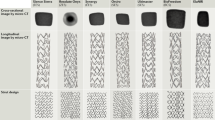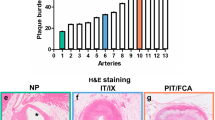Abstract
By-pass surgery and percutaneous transluminal (coronary) angioplasty, PT(C)A, are standard techniques for the treatment of vascular occlusions. Their usefulness is limited by by-pass graft failure and restenosis occuring after the procedures. Twenty percent of patients treated with PTCA/PTA need a new revascularization procedure within 6 months, despite a successful procedure. Stents are used to prevent restenosis in selected lesions, but in-stent restenosis also remains an important clinical problem. In this review we discuss progress of gene therapy for the treatment of post-PT(C)A restenosis, in-stent restenosis and by-pass graft stenosis over the last 2 years (2000–2002).
This is a preview of subscription content, access via your institution
Access options
Subscribe to this journal
Receive 12 print issues and online access
$259.00 per year
only $21.58 per issue
Buy this article
- Purchase on Springer Link
- Instant access to full article PDF
Prices may be subject to local taxes which are calculated during checkout
Similar content being viewed by others
References
Laitinen M et al. Catheter-mediated vascular endothelial growth factor gene transfer to human coronary arteries after angioplasty Hum Gene Ther 2000 11: 263–270
Hiltunen MO, Turunen MP, Ylä-Herttuala S . Gene therapy methods in cardiovascular diseases Meth Enzymol 2002 346: 311–320
Hiltunen MO et al. Biodistribution of adenoviral vector to nontarget tissues after local in vivo gene transfer to arterial wall using intravascular and periadventitial gene delivery methods FASEB J 2000 14: 2230–2236
Nicklin SA et al. Selective targeting of gene transfer to vascular endothelial cells by use of peptides isolated by phage display Circulation 2000 102: 231–237
Hall FL et al. Molecular engineering of matrix-targeted retroviral vectors incorporating a surveillance function inherent in von Willebrand factor Hum Gene Ther 2000 11: 983–993
Ribault S et al. Chimeric smooth muscle-specific enhancer/promoters: valuable tools for adenovirus-mediated cardiovascular gene therapy Circ Res 2001 88: 468–475
Gordon EM et al. Lesion-targeted injectable vectors for vascular restenosis Hum Gene Ther 2001 12: 1277–1287
Nicklin SA et al. Efficient and selective AAV2-mediated gene transfer directed to human vascular endothelial cells Mol Ther 2001 4: 174–181
Nicklin SA et al. Ablating adenovirus type 5 fiber-CAR binding and HI loop insertion of the SIGYPLP peptide generate an endothelial cell-selective adenovirus Mol Ther 2001 4: 534–542
Nicklin SA et al. Ablating adenovirus type 5 fiber-CAR binding and HI loop insertion of the SIGYPLP peptide generate an endothelial cell-selective adenovirus Turunen MP et al. Peptide re-targeted adenovirus encoding tissue inhibitor of metalloproteinase-1 decreases restenosis after intravascular gene transfer. Mol Ther 2002 (in press).
Ylä-Herttuala S, Martin JF . Cardiovascular gene therapy Lancet 2000 355: 213–222
Kibbe MR et al. Optimizing cardiovascular gene therapy: increased vascular gene transfer with modified adenoviral vectors Arch Surg 2000 135: 191–197
Hay CM et al. Enhanced gene transfer to rabbit jugular veins by an adenovirus containing a cyclic RGD motif in the HI loop of the fiber knob J Vasc Res 2001 38: 315–323
Mizuguchi H et al. CAR- or alhav integrin-binding ablated adenovirus vectors, but not fiber-modified vectors containing RGD peptide, do not change the systemic gene transfer properties in mice Gene Therapy 2002 9: 769–776
Eslami MH et al. Gene delivery to in situ veins: differential effects of adenovirus and adeno-associated viral vectors J Vasc Surg 2000 31: 1149–1159
Skelly CL et al. Prevention of restenosis by a herpes simplex virus mutant capable of controlled long-term expression in vascular tissue in vivo Gene Therapy 2001 8: 1840–1846
Roks AJ et al. Recombinant Semliki Forest virus as a vector system for fast and selective in vivo gene delivery into balloon-injured rat aorta Gene Therapy 2002 9: 95–101
Airenne KJ et al. Baculovirus-mediated periadventitial gene transfer to rabbit carotid artery Gene Therapy 2000 7: 1499–1504
Amabile PG et al. High-efficiency endovascular gene delivery via therapeutic ultrasound J Am Coll Cardiol 2001 37: 1975–1980
Klugherz BD et al. Gene delivery from a DNA controlled-release stent in porcine coronary arteries Nat Biotechnol 2000 18: 1181–1184
Klugherz BD et al. Gene delivery to pig coronary arteries from stents carrying antibody-tethered adenovirus Hum Gene Ther 2002 13: 443–454
Panetta CJ et al. A tissue-engineered stent for cell-based vascular gene transfer Hum Gene Ther 2002 13: 433–441
Brasen JH et al. Angiogenesis, vascular endothelial growth factor and platelet-derived growth factor-BB expression, iron deposition, and oxidation-specific epitopes in stented human coronary arteries Arterioscler Thromb Vasc Biol 2001 21: 1720–1726
Yoshimura S et al. Inhibition of intimal hyperplasia after balloon injury in rat carotid artery model using cis-element ‘decoy’ of nuclear factor-kappaB binding site as a novel molecular strategy Gene Therapy 2001 8: 1635–1642
Nakamura T et al. Molecular strategy using cis-element ‘decoy’ of E2F binding site inhibits neointimal formation in porcine balloon-injured coronary artery model Gene Therapy 2002 9: 488–494
Kipshidze NN et al. Intramural coronary delivery of advanced antisense oligonucleotides reduces neointimal formation in the porcine stent restenosis model J Am Coll Cardiol 2002 39: 1686–1691
Maillard L et al. Effect of percutaneous adenovirus-mediated Gax gene delivery to the arterial wall in double-injured atheromatous stented rabbit iliac arteries Gene Therapy 2000 7: 1353–1361
Leppanen O et al. Intimal hyperplasia recurs after removal of PDGF-AB and -BB inhibition in the rat carotid artery injury model Arterioscler Thromb Vasc Biol 2000 20: E89–E95
Ding H et al. Adenovirus-mediated expression of a truncated PDGFbeta receptor inhibits thrombosis and neointima formation in an avian arterial injury model Thromb Haemost 2001 86: 914–922
Hiltunen MO et al. Intravascular adenovirus-mediated VEGF-C gene transfer reduces neointima formation in balloon-denuded rabbit aorta Circulation 2000 102: 2262–2268
Rutanen J et al. EGD-D is abundantly expressed in human arteries and gene transfer of VEGF-DΔNΔC reduces neointima formation in balloon-denuded rabbit aorta Mol Ther 2002 5: S354–S355
Hayashi K et al. In vivo transfer of human hepatocyte growth factor gene accelerates re-endothelialization and inhibits neointimal formation after balloon injury in rat model Gene Therapy 2000 7: 1664–1671
Hayashi K et al. In vivo transfer of human hepatocyte growth factor gene accelerates re-endothelialization and inhibits neointimal formation after balloon injury in rat model Laukkanen MO. Adenovirus-mediated extracellular superoxide dismutase gene therapy reduces neointima formation in balloon denuded rabbit aorta. Circulation 2002 (in press).
Quarck R et al. Adenovirus-mediated gene transfer of human platelet-activating factor-acetylhydrolase prevents injury-induced neointima formation and reduces spontaneous atherosclerosis in apolipoprotein E-deficient mice Circulation 2001 103: 2495–2500
Zoldhelyi P et al. Local gene transfer of tissue factor pathway inhibitor regulates intimal hyperplasia in atherosclerotic arteries Proc Natl Acad Sci USA 2001 98: 4078–4083
Golino P et al. Expression of exogenous tissue factor pathway inhibitor in vivo suppresses thrombus formation in injured rabbit carotid arteries J Am Coll Cardiol 2001 38: 569–576
Atsuchi N et al. Combination of a brief irrigation with tissue factor pathway inhibitor (TFPI) and adenovirus-mediated local TFPI gene transfer additively reduces neointima formation in balloon-injured rabbit carotid arteries Circulation 2001 103: 570–575
Puhakka HP et al. eptide re-targeted adenoviral combination gene therapy coding TIMP-1 and VEGF-C has a long term effect on reducing restenosis Mol Ther 2002 5: S163
Leppänen O et al. Combination of VEGF-C gene transfer and treatment with the PDGF receptor kinase inhibitor STI571 leads to persistent reduction in neointima formation in balloon-denuded rabbit aorta J Am Coll Cardiol 2002 39: 872
George SJ et al. Inhibition of late vein graft neointima formation in human and porcine models by adenovirus-mediated overexpression of tissue inhibitor of metalloproteinase-3 Circulation 2000 101: 296–304
Ehsan A et al. Long-term stabilization of vein graft wall architecture and prolonged resistance to experimental atherosclerosis after E2F decoy oligonucleotide gene therapy J Thorac Cardiovasc Surg 2001 121: 714–722
Ohno N et al. Accelerated reendothelialization with suppressed thrombogenic property and neointimal hyperplasia of rabbit jugular vein grafts by adenovirus-mediated gene transfer of C-type natriuretic peptide Circulation 2002 105: 1623–1626
Ohno N et al. Accelerated reendothelialization with suppressed thrombogenic property and neointimal hyperplasia of rabbit jugular vein grafts by adenovirus-mediated gene transfer of C-type natriuretic peptide Grube, E. E2F Decoy-gene therapy in bypass grafts. American Heart Association 2001 Meeting (Plenary Session: Late Breaking Clinical Trials). 2001.
Makinen K et al. Increased vascularity detected by digital subtraction angiography after VEGF gene transfer to human lower limb artery: a randomized, placebo-controlled, double-blinded phase II study Mol Ther 2002 6: 127–133
Kutryk MJ et al. Local intracoronary administration of antisense oligonucleotide against c-myc for the prevention of in-stent restenosis. Results of the randomized investigation by the thoraxcenter of antisense dna using local delivery and ivus after coronary stenting (ITALICS) trial J Am Coll Cardiol 2002 39: 281–287
Tsui LV et al. p27-p16 fusion gene inhibits angioplasty-induced neointimal hyperplasia and coronary artery occlusion Circ Res 2001 89: 323–328
Wu CH et al. Inhibition of neointimal formation in porcine coronary artery by a Ras mutant J Surg Res 2001 99: 100–106
Condorelli G et al. Mutated p21/WAF/CIP transgene overexpression reduces smooth muscle cell proliferation, macrophage deposition, oxidation-sensitive mechanisms, and restenosis in hypercholesterolemic apolipoprotein E knockout mice FASEB J 2001 15: 2162–2170
Ascher E et al. Effect of p53 gene therapy combined with CTLA4Ig selective immunosuppression on prolonged neointima formation reduction in a rat model Ann Vasc Surg 2000 14: 385–392
Luo Z et al. Enhancement of Fas ligand-induced inhibition of neointimal formation in rabbit femoral and iliac arteries by coexpression of p35 Hum Gene Ther 2001 12: 2191–2202
Larson RA et al. Adenoviral-mediated uteroglobin gene transfer inhibits neointimal hyperplasia after balloon injury in the rat carotid artery J Vasc Surg 2000 32: 1111–1117
Yamamoto K et al. Ribozyme oligonucleotides against transforming growth factor-beta inhibited neointimal formation after vascular injury in rat model: potential application of ribozyme strategy to treat cardiovascular disease Circulation 2000 102: 1308–1314
Eto Y et al. Gene transfer of dominant negative Rho kinase suppresses neointimal formation after balloon injury in pigs Am J Physiol Heart Circ Physiol 2000 278: H1744–H1750
Varenne O et al. Percutaneous gene therapy using recombinant adenoviruses encoding human herpes simplex virus thymidine kinase, human PAI-1, and human NOS3 in balloon-injured porcine coronary arteries Hum Gene Ther 2000 11: 1329–1339
Lamfers ML et al. In vivo suppression of restenosis in balloon-injured rat carotid artery by adenovirus-mediated gene transfer of the cell surface-directed plasmin inhibitor ATF.BPTI Gene Therapy 2001 8: 534–541
Izumi Y et al. Gene transfer of dominant-negative mutants of extracellular signal-regulated kinase and c-Jun NH2-terminal kinase prevents neointimal formation in balloon-injured rat artery Circ Res 2001 88: 1120–1126
Acknowledgements
This study was supported by grants from Finnish Academy and Sigrid Juselius Foundation. We thank Ms Marja Poikolainen for preparing the manuscript.
Author information
Authors and Affiliations
Rights and permissions
About this article
Cite this article
Rutanen, J., Puhakka, H. & Ylä-Herttuala, S. Post-intervention vessel remodeling. Gene Ther 9, 1487–1491 (2002). https://doi.org/10.1038/sj.gt.3301866
Received:
Accepted:
Published:
Issue Date:
DOI: https://doi.org/10.1038/sj.gt.3301866



